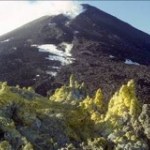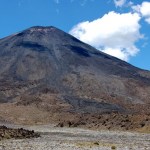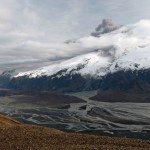seismicity
This is Part 2 of 3 from guest blogger Dr. Boris Behncke. Check out Part 1 here.
The current dynamics and activity of Etna
by guest blogger Dr. Boris Behncke
The recent behavior of Etna is characterized by nearly continuous eruptive activity from the summit craters and eruptions from new vents on the flanks at intervals of a few years to decades. Summit eruptions vary from quiet lava emission to mild Strombolian explosions to high-discharge-rate Hawaiian to sub-Plinian style lava and fire fountaining accompanied by the emplacement of fast-moving lava flows; usually the strongest activity…
A new Weekly Volcanic Activity Report from the Smithsonian and USGS Global Volcanism Program!
Highlights from this week's report include:
Things are getting a little noisy in Colombia. I mentioned a few weeks ago about a possible explosion at Nevado del Ruiz. Now we have reports of increased seismicity under nearby Cerro MachÃn and ash plumes from Nevado del Huila. After a few centuries of relative quiet, it looks like the volcanoes of the Colombian Andes are looking more lively.
Also in South America, a gas plume was spotted at Chile's Planchon-Peteroa. This is the second time this year…
Kilauea lavas on the move near Kalapana. Image taken July 17, courtesy of the Hawaiian Volcano Observatory.
Some news over the last few days:
The lava flows from Kilauea are moving with a vengeance right now, damaging roads and heading for some structures. The lava flows near Kalapana have moved almost 200 meters since Sunday, closing within 100 yards of homes in the area. The lava is moving to the east along Highway 130 and 137 - and tourists are making it difficult to get around as they park to watch the lava - upwards of 2,000 people! A number of people (and dogs) have had to be…
Quick hits to wrap up the week:
Looking into a skylight at Kilauea. Image taken July 8, 2010, courtesy of HVO/USGS.
Following up some news about Changbaishan/Changbai caldera in North Korea, Yang Qingfu, director of earthquake and volcano analysis and forecast center with the seismology bureau of northeast China's Jilin Province, says that the volcano appears to be quiet and that there are no signs of an impending eruption - at least not in the next dozen years. The bigger news (in my mind) is that China will be installing full monitoring (gravity, deformation, electromagnetics, fluid…
The latest news from the world of volcanoes, brought to us by the Global Volcanism Program, USGS and the Smithsonian Institution. They are also brought to us by Sally Kuhn Sennert - and if you have a question for her about her job at the GVP preparing the Weekly Volcanic Activity Report and all things volcanic (and hopefully it won't end like another recent volcanically-mitigated interview).
Some highlights (not including Gorely and Sakurajima):
Ioto (aka Iwojima) in the Volcano Islands of Japan produced an ash plume of unknown height. The volcano has frequent phreatic eruptions and abundant…
News for Monday!
Ngauruhoe in New Zealand, showing the dark lava flows of basaltic andesite on the slopes of the young volcanic cone. Image by Erik Klemetti, taken January 2009.
A couple pieces of news from two Russian volcanoes on the Kamchatka Peninsula: (1) last week's report of activity at Gorely appears to be semi-substantiated with new photos on the KVERT website (Russian). The images from June 6 and 12 (2010) shows steam plumes coming from the volcano - one as tall as 500 meters. Now, this doesn't imply that an eruption occurred, but it might suggest activity on on the upswing. KVERT…
Have guests in town, so I'm a little busy, but you can hopefully keep entertained with the latest Smithsonian/USGS Global Volcanism Program Volcanic Activity Report.
Chile's Melimoyu volcano.
The highlights (not including Taal and Eyjafjallajökull) include:
Alaska's Cleveland volcano has been reduced to and alert status of "unassigned" (used when a volcano is not closely monitored so AVO doesn't know what exactly is "background") after a few weeks of activity. The same was done for the submarine volcano south of Sarigan in the Marianas Islands after no signs of activity since the eruption…
A partially-eroded scoria cone in the Taal volcano caldera.
As I mentioned earlier this week, PHIVOLCS has raised the Alert Status at Taal in the Philippines to 2 (out of 5) after increasing tremors and gas emissions from the volcano's crater lakes. Now, the Philippine government is taking this threat very serious, sending divers, helicopters, rescue equipment and medical teams to the area near the volcano in case an eruption occurs. Provincial officials in Batangas have asked 5,000 people living near Taal to voluntarily evacuate - however, as with many evacuations, people are reluctantly to…
The steaming vent area at Taal in the Philippines in September 1965, when the volcano produced a VEI 4 eruption.
The Philippine Institute of Volcanology and Seismology (PHIVOLCS) has raised the alert status at Taal to Level 2 (of 4) and officials in the Philippines are getting ready if the volcano does come back to life for the first time since 1977. Taal is a mere 48 km (30 miles) from Manila - the capital of the Philippines and home to over 21,000,000 people in the metro area of the city. This location made Taal one of the UN/IAVCEI Decade Volcanoes as a large eruption from the volcano…
Looking for some volcano news - you've found it.
A shot of volcano "tourists" near the erupting Pacaya. Photo by the Associated Press.
Eruptions reader Dr. Boris Behncke dropped a note that Kilauea has not one but two active lava lakes right now. The lava lakes can be seen on the webcams for the Halema`uma`u Crater and the Pu`u O`o flank vent. The latest status update from June 6th by the USGS Hawaiian Volcano Observatory talks about both the summit and rift activity (video) on Kilauea as well. Meanwhile, Hawaii 24/7 has a piece in the Volcano Watch series about whether residents of Maui…
Image of the Eyjafjallajökull's ash taken on May 26, 2010, courtesy of the NASA Earth Observatory.
Eruptions readers were closely following increasing tremors at Eyjafjallajökull this afternoon/evening wondering if there was a new eruption starting but with the weather not cooperating, no one was sure. However, this evening the Icelandic Met Office released a statement (Icelandic) saying that a small explosion of gas and ash did occur today. The update is only available (so far) on the Icelandic version of the IMO website - so I had to work through a Google Translate version of the story…
Some news for a sleepy Monday:
Mt. Hood in Oregon.
The ash from Eyjafjallajökull is, once again, causing significant airspace closure over northern Europe - close of 1,000 flights today. However, much of the closures are fairly short-lived, but that isn't keeping people happy. The eruption hasn't actually changed much, just that the winds are bringing ash towards Europe. The ash for the next few days will likely effect the England, Scotland, Ireland, Netherlands, France and possibly other parts of northern Europe (along with airspace over Greenland and the north Atlantic). The ash plume is…
I an in the home stretch for grading exams, so just a quick update for today:
The evidence of floods from the Eyjafjallajökull eruption, taken on May 1, 2010 by Dr. Joe Licciardi.
Airports now as far south as Spain, Morocco and the Canary Islands are facing closures due to the Eyjafjallajökull ash. The latest London VAAC ash advisory has the ash wrapping around western and southern Europe, which I am sure is making life interesting for routing transatlantic flights into Europe. The flights within Europe don't seem to be that effected according to Eurocontrol - and they have even dropped…
Hard to believe, but there is other volcano-related news in the world ...
So, with all deference to Eyjafjallajokull, here it is:
Dome collapse on Colima in Mexico, image taken March 30, 2010.
The new Smithsonian/USGS GVP Weekly Volcano Activity Report was issued, with news about increasing signs of activity at Egon in Indonesia, a possible plume at Miyakejima in Japan and more dome growth at Soufriere Hills.
A study on the economic effect of a new Vesuvius eruption was released and the finding show the potential for a staggering $24 billion of economic damage directly related to an…
The steam and ash plume from the Eyjafjallajökull subglacial eruption that started early morning, April 14, 2010.
Well, after the brief respite when there was speculation Eyjafjallajökull-Fimmvörduháls eruption might be over, we now know what was going on. After the original fissures ceased activity, the magma found a new route to the surface, this time underneath the Eyjafjallajökull glacier. Eruptions readers last night watched as an earthquake swarm arrived underneath the icecap, which prompted Icelandic officials to start evacuating people from the area around the volcano (photo…
The Eyjafjallajökull-Fimmvörduháls eruption at night on April 10, 2010.
I mentioned this earlier in the Monday Musings column, but the Eyjafjallajökull-Fimmvörduháls eruption in Iceland that started last month seems to be at a nadir of activity since its inception. This is being interpreted by the Icelandic Met Office as a sign that the eruption itself may be winding down after less than a month of activity - the earthquakes and inflation associated with the eruption appears to be subsiding along with the actual eruptive activity. Now, there is always the chance that the fissure will…
Lots to do!
Tourists flock to the Eyjafjallajökull-Fimmvörduháls in Iceland.
The media does love the term "supervolcano", and a number of Eruptions readers sent me a link to the article on the dreaded submarine "supervolcanoes". I would delve into this article from Live Science, but it sadly again does a dreadful job with a lot of this - remember, "supervolcano" is a made-up word by the BBC with no strict definition, so trying to say there are a dozen supervolcanoes worldwide is just silly. And why does it take multiple paragraphs and multiple mentions of "scientists" before they get a…
A view of the steaming Mt. Etna, taken on April 8, 2010 by Dr. Boris Behncke.
Eruptions reader and member at Italian National Institute of Geophysics and Volcanology in Catania, Dr. Boris Behncke, has been keeping many of us appraised on the goings-on at Mt. Etna. A series of earthquakes occurred on April 2-3 along a fault near the north flank of the volcano - 175 earthquakes in all producing some impressive results - and Boris has noted increased "rumblings" at Etna since. This has culminated in explosions and ash April 7-8. Most of the ash appears to be made from merely crushed rock of…
Actually, no the volcanoes aren't from space, but pictures of the volcanoes were taken from space. The NASA Earth Observatory has posted three more gems of volcanic activity taken by one of the fleet of earth imagers in orbit:
A recent image of Chaiten taken by EO-1. Image courtesy of the NASA Earth Observatory.
There is a great image of the busy Kamchatkan Peninsula, where four volcanoes are seen erupting in a single image - Kliuchevskoi, Bezymianny, Shiveluch and Karymsky. The plume from Karymsky is especially prominent as a grey streak above the white snow of the Russian winter (albeit…
The steam plume from the new dome on Redoubt, taken in January 2010. Image courtesy of USGS/AVO, taken by Dennis Anderson.
News comes out of Alaska that a small earthquake swarm has begun under Redoubt. This is the second such swarm since the volcano's 2009 activity ceased. Most of the seismicity appears to be near the summit of the volcano, which would suggest that magma might be moving underneath the new dome that is still steaming.
AVO describes the unrest:
"This morning, at roughly 01:44 AKDT (0944 UTC) a series of small repetitive earthquakes began occurring in the vicinity of the…


